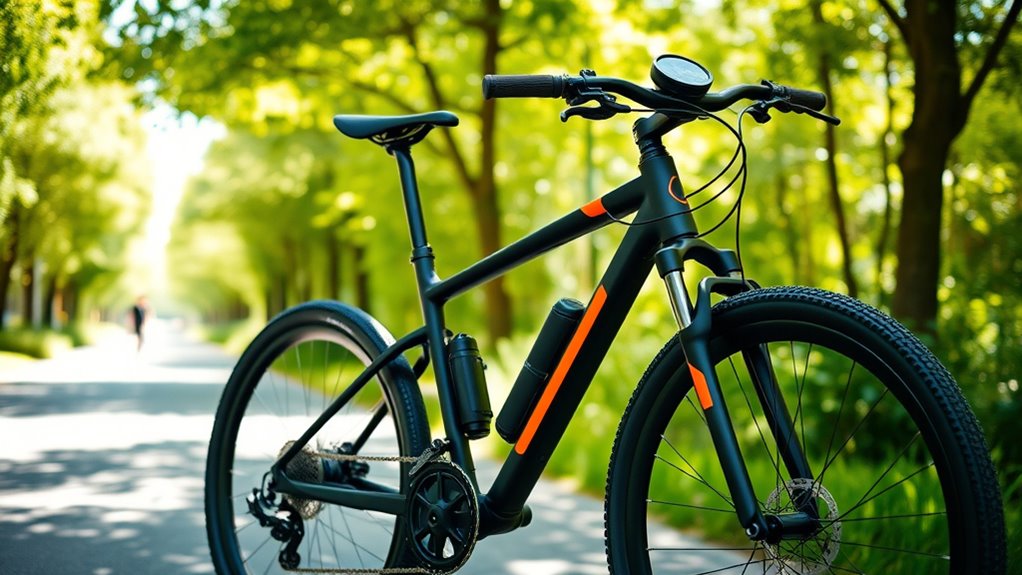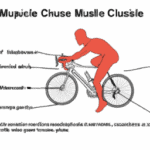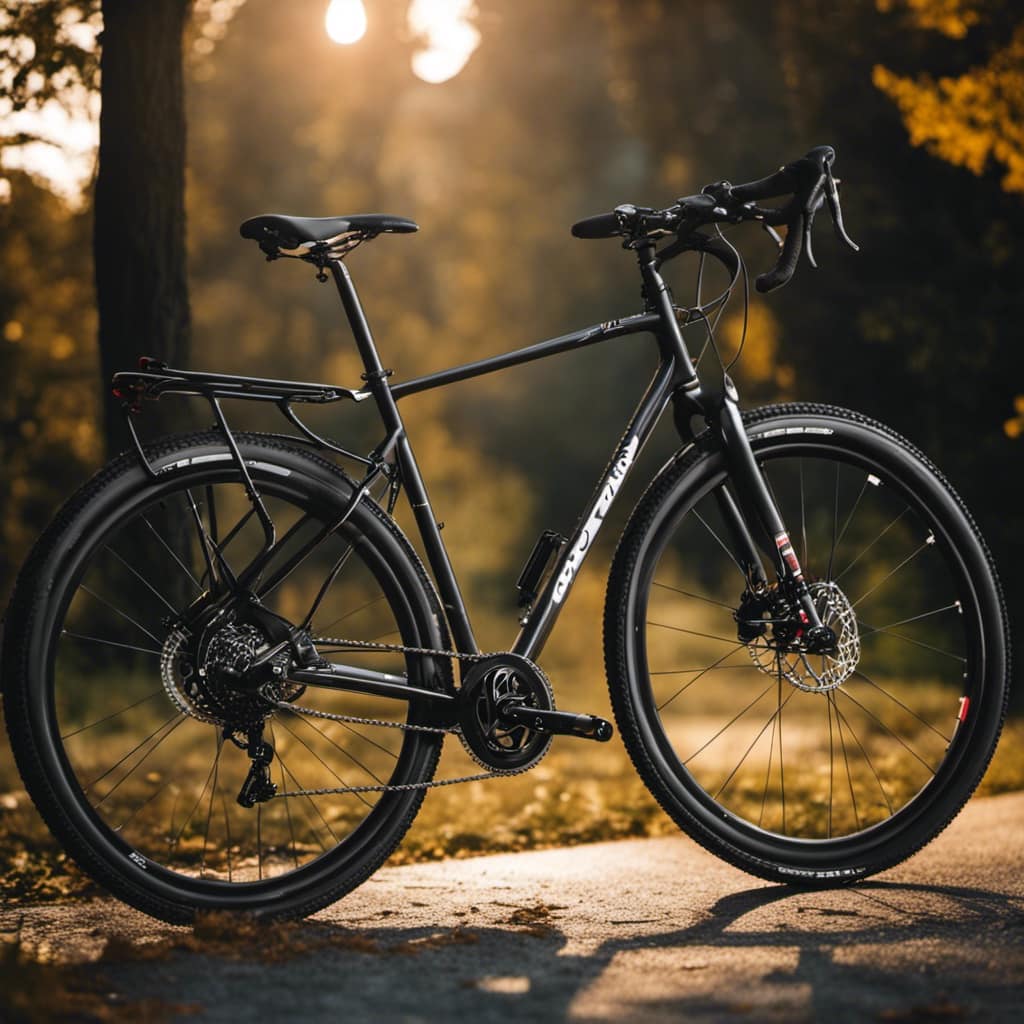To get the most out of your hybrid bike for fitness, focus on proper bike fit, maintaining an upright posture, and adjusting saddle height for comfort and efficiency. Use a range of gears to handle hills and flats smoothly, and incorporate interval training to boost endurance. Keep your bike well-maintained with regular cleaning, check tire pressure, and inspect brakes. Enhancing comfort with accessories and tracking your progress will help you achieve your fitness goals more effectively.
Key Takeaways
- Adjust saddle height and handlebar position for comfort, optimal ergonomics, and efficient pedaling during fitness rides.
- Incorporate interval training and varied terrains to maximize cardiovascular benefits and prevent workout plateaus.
- Regularly maintain tires, brakes, and drivetrain to ensure safe, smooth, and reliable performance.
- Use appropriate gear ratios and smooth shifting to handle different terrains with less fatigue.
- Track ride data and set fitness goals to monitor progress and stay motivated over time.
Optimizing Bike Fit and Posture for Effective Workouts
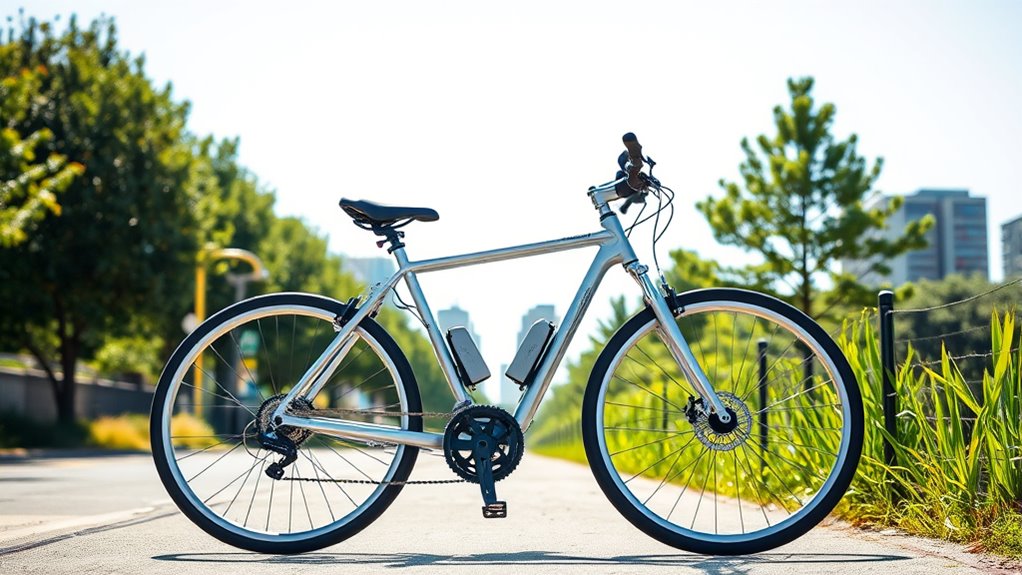
To get the most out of your hybrid bike workouts, it’s essential to optimize your bike fit and posture. Start by adjusting the saddle height so there’s a slight bend in your knee at the bottom of the pedal stroke, which maximizes power and reduces fatigue. Maintain an upright riding posture by setting the handlebars at a comfortable height to prevent back and neck strain during extended workouts. Ensure your saddle is level and aligned with the handlebars for better bike ergonomics, promoting efficient pedaling and muscle engagement. Your reach to the handlebars should allow a slight bend in your elbows, improving control and balance. Regular comfort adjustments based on ride duration and intensity help sustain proper bike fit, ensuring a comfortable, effective workout every time. Incorporating bike fit adjustments can further enhance your riding efficiency and comfort, especially when considering proper posture to prevent strain and injury. Additionally, paying attention to drivetrain maintenance can ensure smooth gear shifting and optimal performance during your rides. Being attentive to bike maintenance can also prevent mechanical issues that might disrupt your workout. Regularly reviewing your bike’s components can help identify potential issues before they impact your ride.
Selecting the Right Gearing for Varying Terrains
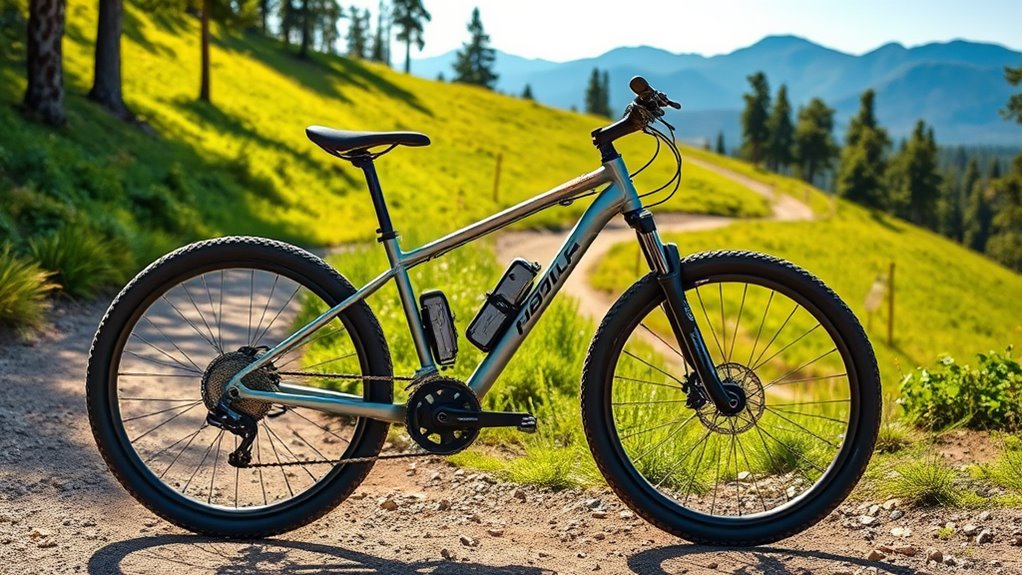
Choosing the right gear ratios can make a big difference when riding on different terrains. If you encounter hills frequently, a wide-range cassette and larger chainrings help you climb with less effort. Matching your gears to the terrain guarantees smoother rides and reduces fatigue, keeping your workout effective and enjoyable. Incorporating rustic lighting and vintage furniture can also enhance your overall experience. Paying attention to tire pressure can further improve traction and comfort on varied surfaces. Additionally, understanding personality traits can boost your motivation and persistence during challenging rides. Recognizing the importance of market positioning can help you select the best gear setups for different environments and riders. Moreover, being aware of affairs – cheating husband secrets can remind us of the importance of transparency and trust, even in our pursuits outside the bike.
Matching Gear Ratios
How do you select the right gear ratios for different terrains? It starts with understanding your bike’s gear setup and gear notation, like 2×9 or 3×8, which shows the number of gears and cogs. A wide gear range, such as an 11-42T cassette, offers versatility for steep inclines and fast flats. Adjusting your gear ratios with smooth shifting helps match terrain suitability, whether you’re climbing or cruising. Larger gear jumps, like 11-13-15-17, can improve shifting precision during variable terrain. Consider your fitness level and typical riding conditions to choose a drivetrain with an appropriate gear range. The right gear ratios make pedaling easier on hills and allow for efficient speed on flat surfaces, enhancing your overall riding experience. Additionally, understanding gear compatibility and maintenance can help ensure your drivetrain remains reliable and performs optimally, especially when tackling diverse terrains. Proper drivetrain tuning is essential for maintaining smooth gear shifts and prolonging component lifespan. Furthermore, AI-powered device performance can help optimize your bike’s electronics and accessories for a smarter ride. Being aware of gear ratios and their effects on pedaling efficiency can also contribute to a more comfortable and effective riding experience.
Adjusting for Hills
When riding over hilly terrain, selecting the right gear setup is essential for maintaining an efficient and comfortable cadence. You’ll want gear ratios that make terrain adjustment easier, especially on steep hills. Low gears, enabled by a wide-range cassette like an 11-42T, help you pedal smoothly without exerting excessive effort. Compact chainrings, such as 48 or 50 teeth, combined with larger rear sprockets, allow you to shift into lower gears before tackling inclines. Use your gear shifters with precise, indexed shifting to quickly adapt to changing terrain. Shifting to lower gears before steep hills prevents chain strain and keeps your cadence high, reducing fatigue. Regularly adjusting your gearing ensures a smoother ride and consistent effort, no matter the incline. Additionally, understanding Kia Tuning options can inspire modifications to improve vehicle handling on varied terrains. Exploring Mazda Tuning enhancements can also optimize your vehicle’s performance for diverse landscapes, ensuring a more confident and controlled ride. It’s also beneficial to consider noise levels of heat pumps when planning for a quieter ride, especially for early mornings or late evenings. Being aware of the performance benefits of proper gear selection can further enhance your riding experience, making climbs easier and descents more controlled.
Incorporating Interval Training and Varied Rides

Incorporating interval training and varied rides into your hybrid cycling routine can considerably enhance your fitness gains. By alternating between high-intensity speed intervals and moderate recovery periods, you boost your cycling performance and calorie burn. Use your hybrid bike’s gear range effectively—shifting to climbing gears on hills and higher gears on flats—to simulate interval training benefits. Incorporate varied rides, mixing steady-state rides with challenging hilly segments, to target different muscle groups and prevent plateaus. Scheduling interval sessions once or twice a week will improve endurance and speed over time. A diverse ride variety keeps workouts engaging and maximizes fitness benefits, helping you build strength, stamina, and overall cycling efficiency. Paying attention to your performance metrics can help you track progress and make informed adjustments to your training routine.
Maintaining Your Bike for Safe and Consistent Performance
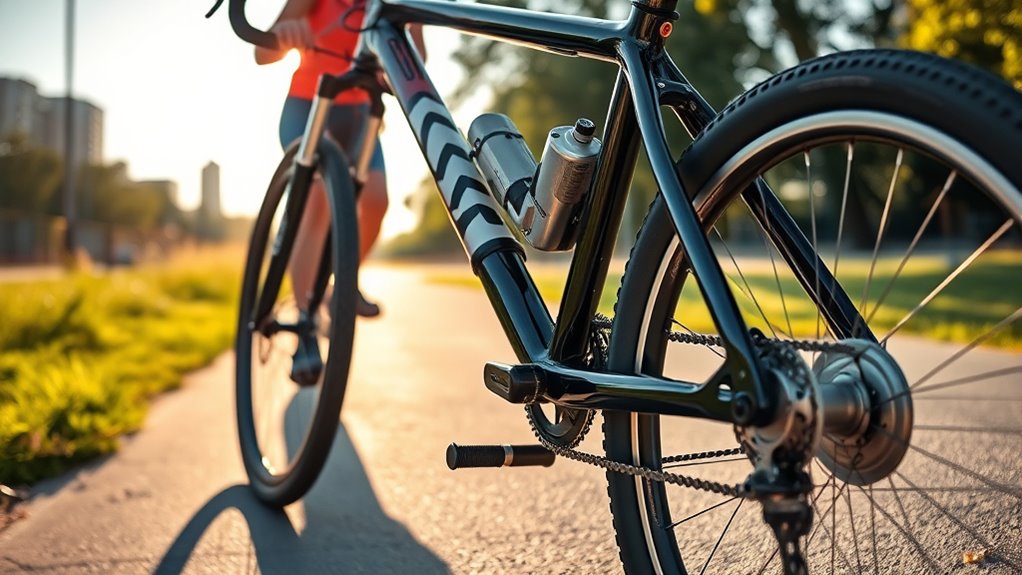
Keeping your bike clean and dry after each ride helps prevent rust and keeps it running smoothly. Regularly inspecting your brake pads guarantees safety and effective stopping power. By staying on top of these maintenance tasks, you’ll enjoy safer rides and consistent performance. Incorporating powerful persuasive words into your maintenance routines can motivate you to stay consistent and attentive to your bike’s needs. Additionally, maintaining proper sensorimotor skills enhances your overall riding experience and safety.
Regular Cleaning Routine
Maintaining a regular cleaning routine is essential for keeping your hybrid bike in safe and ideal condition. Regular washing with mild soap and water removes dirt, grime, and debris that can accelerate component wear. Focus on cleaning the chain, components, and brake pads to prevent buildup that hampers performance. After cleaning, lubricate the chain every 50-100 miles or when it sounds dry, ensuring smooth shifting and rust prevention. Check tire pressure before each ride to maintain efficiency and avoid flats. Regular inspection of bolts, quick releases, and headset components helps prevent loosening and maintains bike stability. Remember, consistent maintenance enhances safety and longevity:
- Keep components clean to avoid premature wear
- Lubricate moving parts for smooth operation
- Tighten bolts to ensure stability
Routine Brake Inspection
How often should you check your bike’s brakes? Regular brake inspection is essential for safe, reliable stopping power. Start by examining your brake pads—ensure they’re at least 1/8 inch thick and replace them if worn down to the indicator line. For disc brakes, inspect rotors for warping, cracks, or excessive wear, and keep them free of debris. Check brake levers for proper feel and engagement; if they’re spongy or require too much travel, brake fluid levels or cable tension might need adjustment. Rim brakes should be checked for uneven wear and replaced if necessary. Always test your brake performance by applying brakes at low speed, listening for squealing or grinding, and making brake adjustments to maintain best stopping power.
Enhancing Comfort With Accessories and Proper Gear

Enhancing your comfort during fitness rides often comes down to choosing the right accessories and gear. Investing in ergonomic grips and padded saddles can drastically reduce hand and sit bone fatigue, making long rides more enjoyable. Fenders and mudguards help keep you dry and clean, especially in wet conditions, boosting ride satisfaction. Proper cycling accessories, such as a quality front or rear rack, increase ride convenience by carrying essentials effortlessly. Additionally, paying attention to tire pressure and selecting wider tires (at least 32mm) improves cushioning and stability, smoothing out bumps. Safety gear, like a bike bell or horn, ensures better awareness and safety. Remember, these comfort enhancements aren’t just about luxury—they make your rides safer, more enjoyable, and more efficient.
Tracking Progress and Setting Fitness Goals

Tracking your progress is essential for staying motivated and improving your fitness on a hybrid bike. By monitoring ride data like speed, distance, and calories burned, you can see exactly how you’re progressing. Setting clear fitness goals, such as riding 10 miles three times a week or increasing your average speed by 2 mph, helps you stay focused. Using app integration or a bike computer makes tracking progress easy, providing detailed performance metrics. These tools allow you to visualize improvements over time and adjust your training intensity accordingly. Recording ride data regularly helps you identify trends and refine your approach. Incorporating interval training and gradually increasing ride difficulty will enhance your cardiovascular fitness and performance, keeping you motivated to reach your fitness goals.
Frequently Asked Questions
Are Hybrid Bikes Good for Fitness?
You’re wondering if hybrid bikes are good for fitness. They’re actually a great choice because they offer an upright riding position that’s comfortable for longer rides, and wider tires for stability. Their lightweight frames and versatile gears let you adjust the intensity easily, helping you build stamina and improve cardiovascular health. Plus, their responsive brakes and smooth shifting make your workouts safer and more enjoyable, making hybrid bikes ideal for fitness-focused riding.
What Type of Bicycle Is Best for Exercise?
You might find it surprising, but the best bicycle for exercise depends on your goals. If you want efficiency and comfort, a fitness hybrid bike is ideal — lightweight, with an upright position and responsive tires, perfect for paved surfaces. It balances speed and cushioning, making your workouts enjoyable. Choose one with reliable gears like Shimano, and you’ll get consistent performance to keep you motivated and moving forward efficiently.
What Are the Disadvantages of a Hybrid Bike?
You should know that hybrid bikes have some downsides. They tend to be heavier than road bikes, which can slow you down and tire you out more quickly. Their wider tires and upright position reduce aerodynamics, limiting speed. Without suspension, rough terrain becomes uncomfortable and wears components faster. Plus, their design makes climbing and handling at high speeds less responsive, so they’re not ideal for performance-focused riding.
What Is the Best Hybrid Bicycle for the Money?
You’re looking for the best hybrid bike for your budget, and the Co-op Cycles CTY 1.1 stands out as a top choice. Priced at $599, it offers a lightweight aluminum frame, reliable mechanical disc brakes, and a versatile 3×8-speed gearing setup. Its excellent value makes it ideal for fitness riding, providing durability and performance without breaking the bank. For a slightly higher budget, the Cannondale Quick 3 offers even more urban features and smooth gear options.
Conclusion
As you pedal through changing landscapes, feel the wind on your face and the rhythm of your ride energize you. With the right fit, gear, and accessories, your hybrid bike becomes a trusted companion on your fitness journey. Keep your bike well-maintained and challenge yourself with interval rides. Each turn of the wheel brings you closer to your goals, transforming every ride into a powerful, invigorating adventure that fuels both body and mind.
